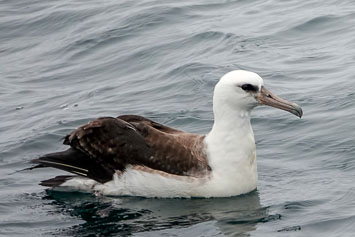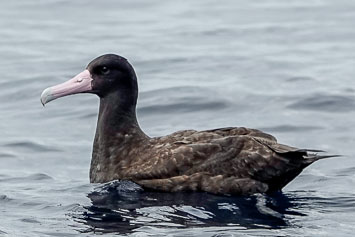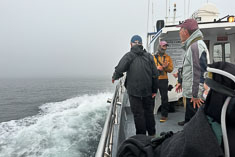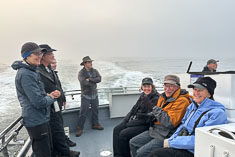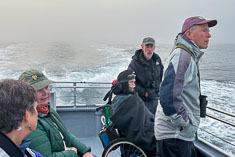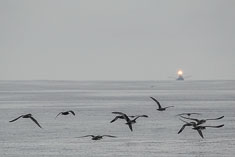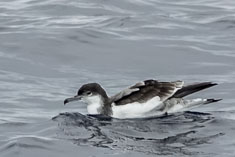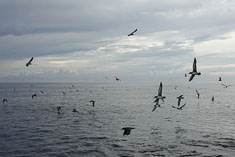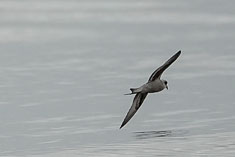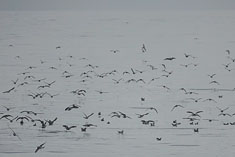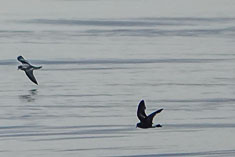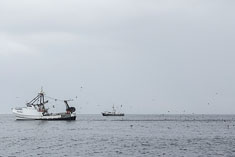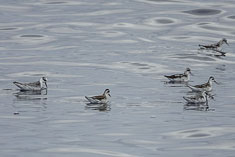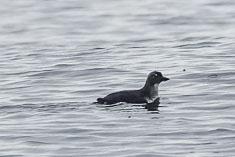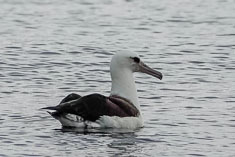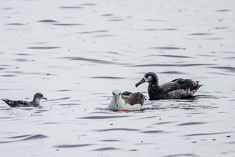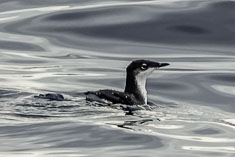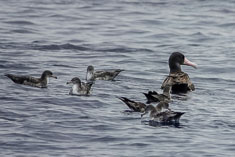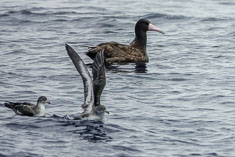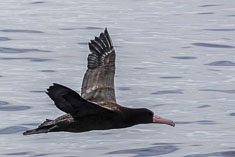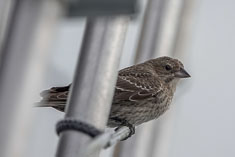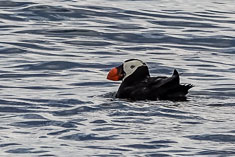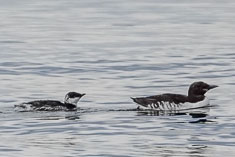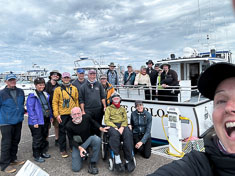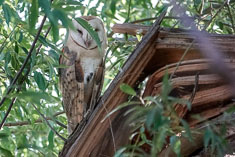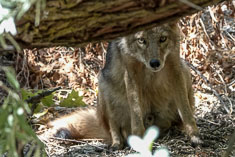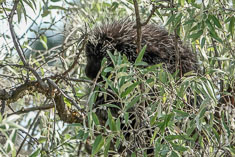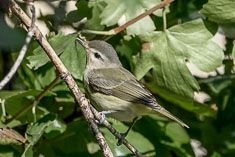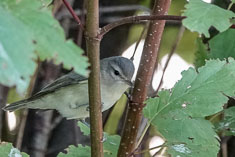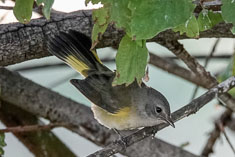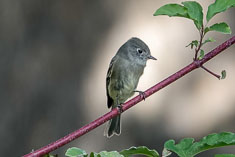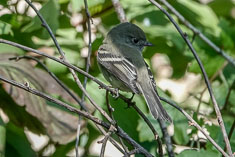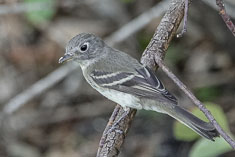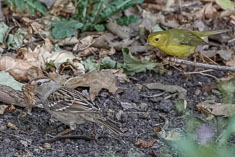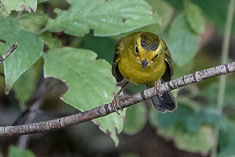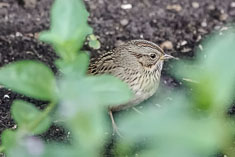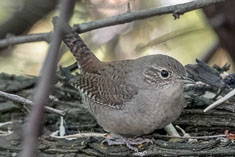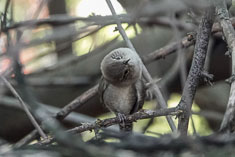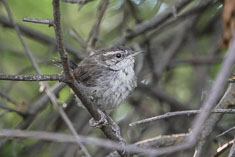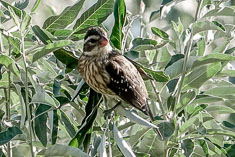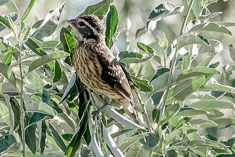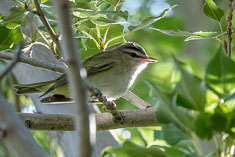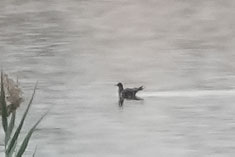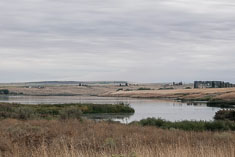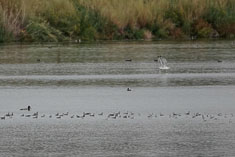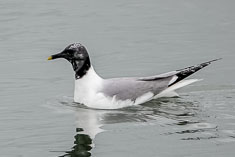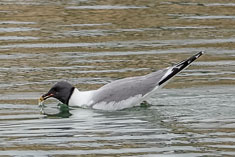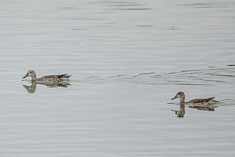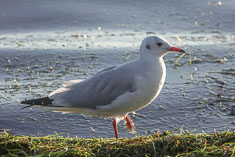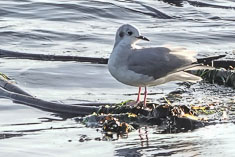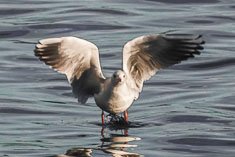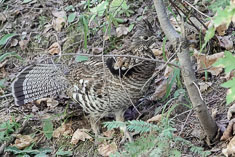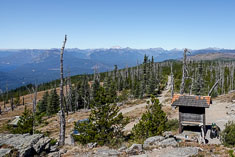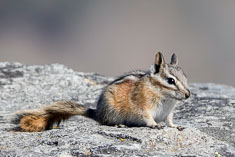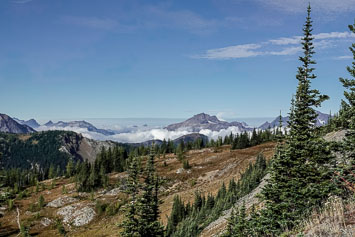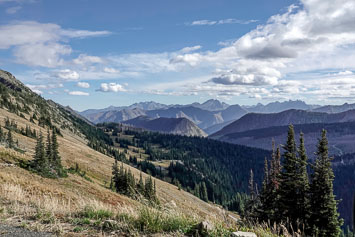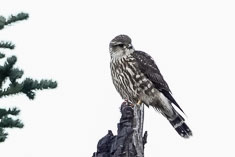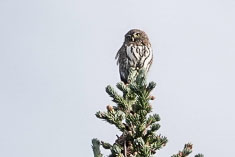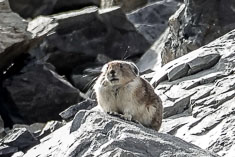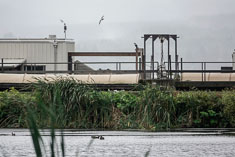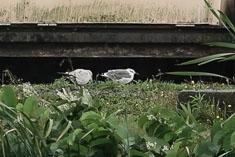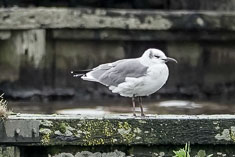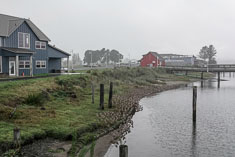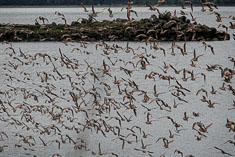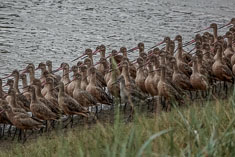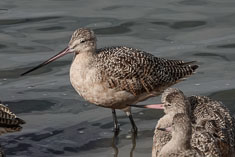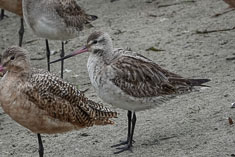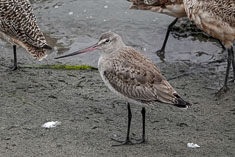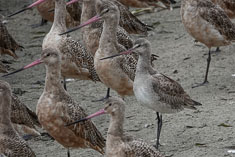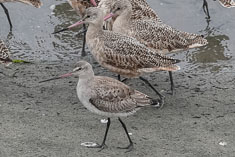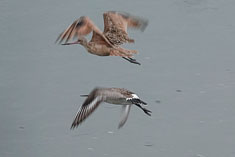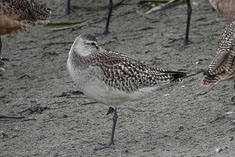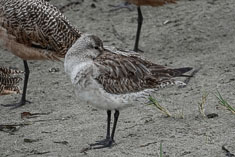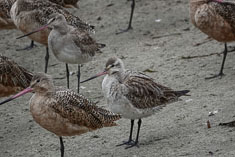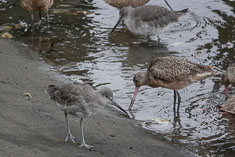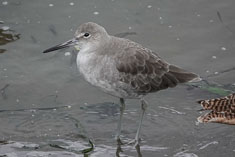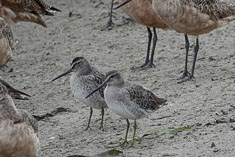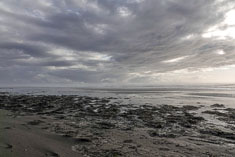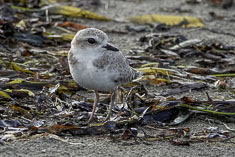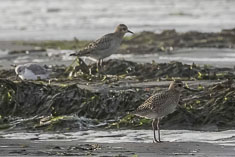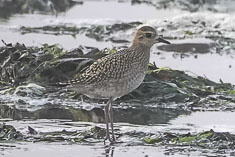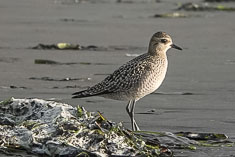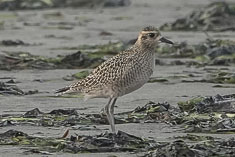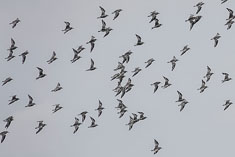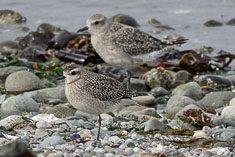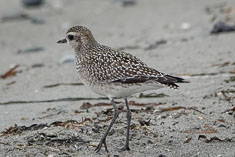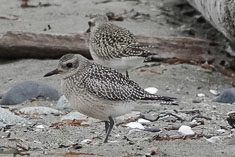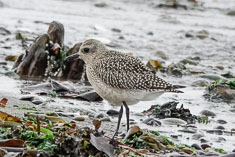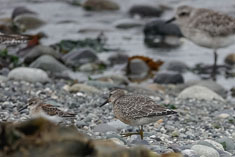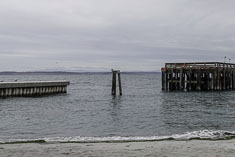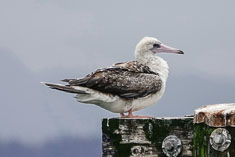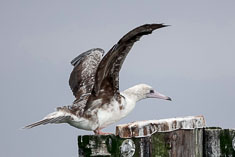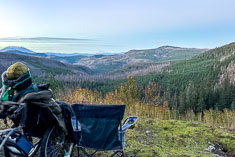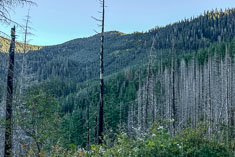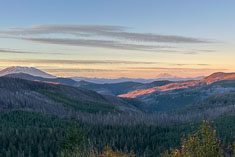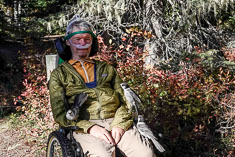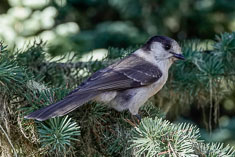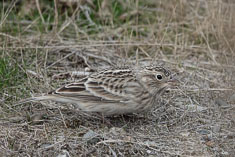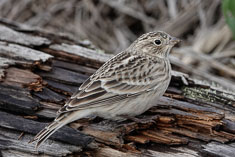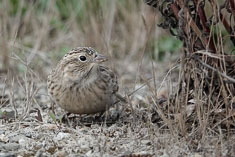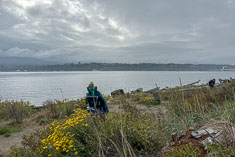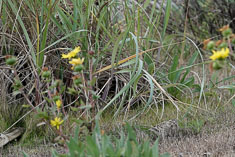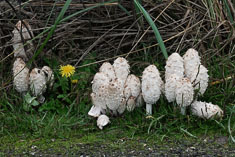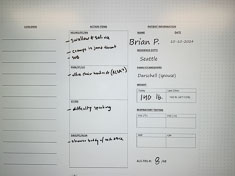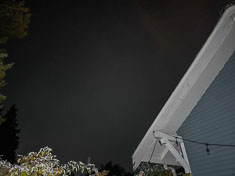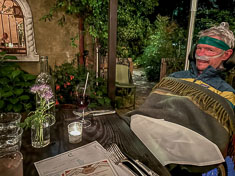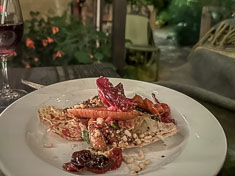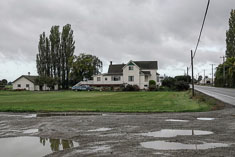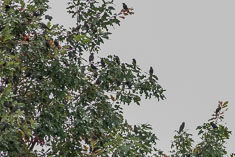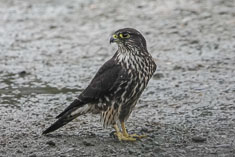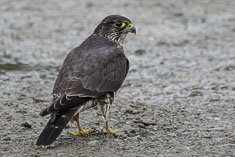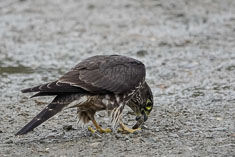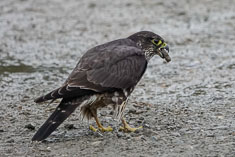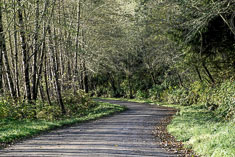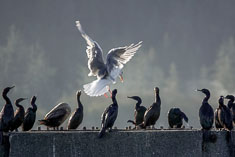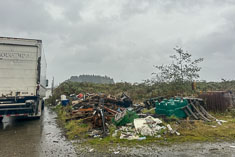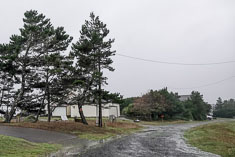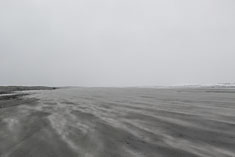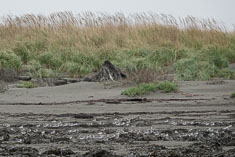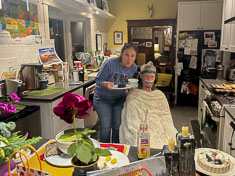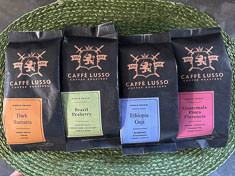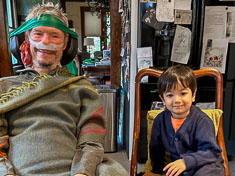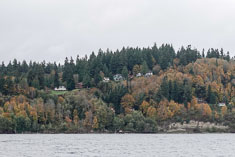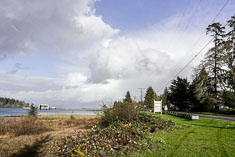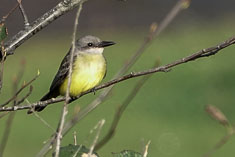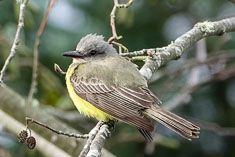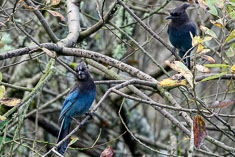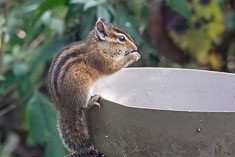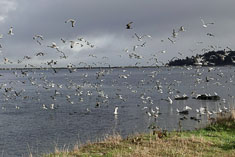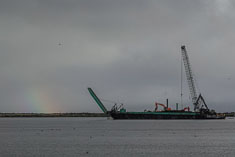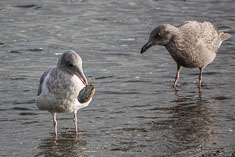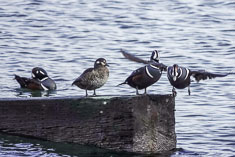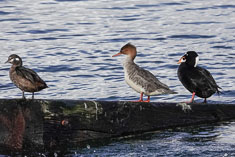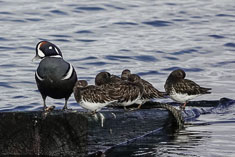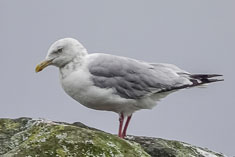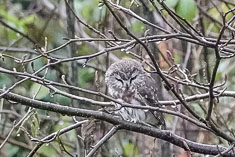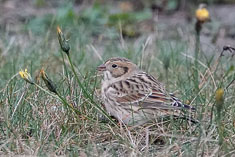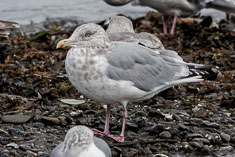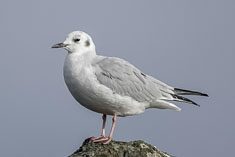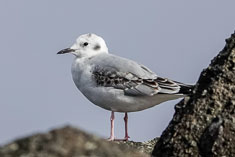7/31/2024 Concluding July (link to here)
During July we drove 1424 miles, spending 4 nights away from home and 5 days birding and submitting 30 complete checklists with 139 species. We added only two new year birds for a total of 312.
During July we drove 1424 miles, spending 4 nights away from home and 5 days birding and submitting 30 complete checklists with 139 species. We added only two new year birds for a total of 312.
8/26/2024 Pelagic Trip (link to here)
Today we had a truly remarkable day of pelagic birding with Westport Seabirds +. Of the 19 pelagic or mostly pelagic birds we might hope to counter on a late-summer trip we missed only two, an impressive feat in itself, but in addition we found three mega-rarities, species which have each been seen fewer than four times in the past four years on 75 trips out of Westport. I'm not sure that has ever happened before in nearly 50 years of Westport pelagic trips.
Although fog had not been in the forecast, mist shrouded the marina when we arrived at Float 10 at
5:30 AM and enveloped us as we motored out of the harbor, across the bar and out to sea. The water
was glassy and almost flat; I've rarely seen the bar so calm. That's not necessarily a good
thing. The birds tend to move around more when they can take advantage of the energy of wind and
waves and when they are on the move, they are often easier to find.
The fog began to thin out as the sun rose behind us but we still were not seeing many birds. We passed, or were passed by, an occasional murre or shearwater but no big flocks so I began to adjust my year bird estimates for the day downward. I had initially figured 12-15 new birds would not be unreasonable but after an hour and half in the fog I was prepared to be content with 10-12.
Not long after that we began to see groups of mostly Pink-footed Shearwaters and Westport Seabirds
started their first checklist - westbound from the 50 fathom line L+. Fork-tailed Storm-Petrels began to show
up, individuals at first then large flocks. They were not new for the year for us but the Buller's
Shearwater in one of the flocks of Pink-foots was one of the birds we were looking for, as was the
Northern Fulmar a few minutes later. Both species are regular but neither has been seen in large
numbers recently. Given that I do not always see every bird, I was grateful to get them.
Two hours out we had our first mega-rarity. Bill was standing next to my wheelchair on the port
side of the boat when, alerted by someone up front, got binoculars on a dark storm-petrel and
shouted "Wilson's Storm-Petrel!" In his words:
Around 9 AM we caught up to several fishing boats trailing large loose flocks of seabirds,
mostly shearwaters but also albatrosses, gulls and jaegers. Westport Seabirds
did a separate checklist for the next three hours and 18 miles covering the
area north of Grays
Canyon L+ near the edge of the continental shelf. As noted in the checklist comments,
With 16 new birds at that point we had already exceeded my mmost optimistic projections when we came
across our second mega-rarity, a Scripps's Murrelet. A small black and white seabird which occasionally
wanders north into Westport waters in the fall, it had not been reported for the past three years. I first
saw one on another memorable pelagic trip back in October 2013; I think it was unusual then too.
Within 10 minutes of leaving the murrelet we were motoring past a another group of Pink-footed
Shearwaters when someone (I think it was Bill again) noticed a very large dark brown bird with a
bright pink bill sitting on the water with them. Short-tailed Albatross! Our third mega-rarity in
three hours, it is the rarest of the three albatrosses which breed in the North Pacific ocean and a
bird which few people on the boat had ever seen. For Darchelle it was particularly exciting; prior
to each of our past three trips she has named the Short-tailed Albatross as the bird she has most
desired to see.
Phil cut the engine and we floated quietly in the company of the rare albatross for almost 15 minutes before the big bird got up, padded across the water and flapped heavily away.
Shortly after we turned to head inbound from Grays Canyon L+ we met up with another bird rarely found 40 miles off Westport, a Brown-headed Cowbird. Although they can be quite tame on land it was nervous on the boat and soon took off low over the water, presumably to its demise. Otherwise the trip in was relatively uneventful though we did pick up our 19th year bird of the day, a Tufted Puffin about 25 miles offshore.
Not only was it an amazing trip in terms of birds, but it was easier than I anticipated as well. I always worry about getting on and off the boat but many people helped and the transfers went without a hitch. Bill, in addition to serving as one of the spotters, was especially helpful to me in pointing out species which I might have overlooked or was unable to identify without optics. Unlike some past trips I never got too cold. Also unlike past trips, I had to pee but Darchelle had brought the bottle and it worked fine. I don't know if we'll do another one next year but if not, what a way to end!
Today we had a truly remarkable day of pelagic birding with Westport Seabirds +. Of the 19 pelagic or mostly pelagic birds we might hope to counter on a late-summer trip we missed only two, an impressive feat in itself, but in addition we found three mega-rarities, species which have each been seen fewer than four times in the past four years on 75 trips out of Westport. I'm not sure that has ever happened before in nearly 50 years of Westport pelagic trips.
The fog began to thin out as the sun rose behind us but we still were not seeing many birds. We passed, or were passed by, an occasional murre or shearwater but no big flocks so I began to adjust my year bird estimates for the day downward. I had initially figured 12-15 new birds would not be unreasonable but after an hour and half in the fog I was prepared to be content with 10-12.
As we were enjoying the FTSP show, one of the participants called out that they had a dark storm
petrel with a white rump. I was able to get on their bird immediately, and noted the extensive
white on the rump wrapped around onto the sides. I immediately called out Wilson's Storm-Petrel and
attempted to get everyone on board on the bird. I noted a dark, almost blackish storm-petrel with
extensive and brightly white rump that continued onto the sides almost to the undertail coverts.
Flight was fairly direct, with relatively shallower wingbeats than nearby FTSP. Wings are broader
in shape than nearby FTSP. When it hovered over the wake, the long legs dangled very obviously.
My view was too distant to identify it without optics but I watched it fly past the boat and over the
wake while Darchelle scrambled to get photos. To my delight she succeeded. Only the seventh state
record, it was a state bird for both of us and our sixth year bird of the trip. Things were looking up!
Ocean conditions were excellent, with essentially no wind (Beaufort 0-1), a light swell from the
west, and overcast skies with occasional light rain.
The birds were excellent too. Along with the Black-footed Albatrosses were several less common
Laysans, a beautiful bird. We saw numerous Sabine's Gulls and Cassin's Auklets, both expected, and
Arctic Terns as well, which we've seen on very few trips. Among the flocks of Red-necked Phalaropes
were a few Red Phalaropes, another bird we needed but were not counting on. Bill pointed out
another hoped-for bird, a Short-tailed Shearwater, in the swirling groups of Pink-footed
Shearwaters. By 11 AM we'd also had good looks at a couple of South Polar Skuas, several
Long-tailed Jaegers and at least one Parasitic Jaeger which, together with the Pomarine we'd seen
earlier, gave us a "Skua Slam" - sightings of all four Washington members of the jaeger family.
That has only happened on about one trip in three over the past four years.Phil cut the engine and we floated quietly in the company of the rare albatross for almost 15 minutes before the big bird got up, padded across the water and flapped heavily away.
Shortly after we turned to head inbound from Grays Canyon L+ we met up with another bird rarely found 40 miles off Westport, a Brown-headed Cowbird. Although they can be quite tame on land it was nervous on the boat and soon took off low over the water, presumably to its demise. Otherwise the trip in was relatively uneventful though we did pick up our 19th year bird of the day, a Tufted Puffin about 25 miles offshore.
Not only was it an amazing trip in terms of birds, but it was easier than I anticipated as well. I always worry about getting on and off the boat but many people helped and the transfers went without a hitch. Bill, in addition to serving as one of the spotters, was especially helpful to me in pointing out species which I might have overlooked or was unable to identify without optics. Unlike some past trips I never got too cold. Also unlike past trips, I had to pee but Darchelle had brought the bottle and it worked fine. I don't know if we'll do another one next year but if not, what a way to end!
8/31/2024 August Totals (link to here)
During August we birded 9 days and spent 11 nights away from home, although 7 of those were for a family reunion in Walla Walla. We drove 2114 miles for an ending odometer reading of 124060. Thanks to our pelagic trip on the 26th which contributed 25 species and the morning of the 31st at Steptoe Butte which added 22, we tallied 151 species for the month on 26 complete checklists. That gives us 337 species for the year in Washington, two fewer than a year ago.
During August we birded 9 days and spent 11 nights away from home, although 7 of those were for a family reunion in Walla Walla. We drove 2114 miles for an ending odometer reading of 124060. Thanks to our pelagic trip on the 26th which contributed 25 species and the morning of the 31st at Steptoe Butte which added 22, we tallied 151 species for the month on 26 complete checklists. That gives us 337 species for the year in Washington, two fewer than a year ago.
9/01/2024 Washtucna (link to here)
We spent the night in Othello and drove over to Washtucna early, arriving at Bassett Park L+ by 6:30 though we didn't park my chair in front of the bush right away. The morning was sunny but cool and there initially wasn't much activity at the bush so we drove around inspecting sparrow flocks. That might have been a mistake; by the time we returned to the bush it was hopping so we might have missed a few early birds.
I still did pretty well in four hours of watching the bush, with close views of Warbling Vireos, Dusky and Hammond's Flycatchers and Wilson's Warblers every few minutes along with an occasional visit by the previously-reported American Redstart, a new bird for the county for me.
The flycatchers were vocalizing which made it easy to distinguish Dusky ("wit") from Hammond's ("peet") and provided an opportunity to compare plumage characteristics between the two species. In the fall migration Dusky Flycatchers haven't molted yet so tend to be more gray overall with more visible feather wear. Hammond's Flycatchers have already molted into fresh plumage with more olive coloration and more contrast in the underparts. They also tend to have a more crested and larger-headed appearance which in turn makes the bill appear smaller. Despite the practice though, at the end of the day a solitary silent bird could still leave me guessing.
Most of the warblers were Wilson's which, like the other species, visited the bush both to bathe
and to forage. Fat moths were the preferred food item though they were neither easy to catch nor
to subdue once caught. The White-crowned Sparrow in the photo on the left above took a couple of
minutes to get its moth under control, with the young Wilson's Warbler all the while watching
intently.
Among the birds which did not visit the bush were the wrens. Darchelle, watching the willows up beyond the swimming pool at the northeast corner of the park, had three species - the two pictured above along with a Rock Wren.
Also in the willows were the two best birds of the day. The Red-eyed Vireo would have been another county bird for me but the grosbeak was also a year bird, putting her one ahead of me in the eBird Top 100 +. Neither bird lingered long enough for her to come down to get me and even if she had, the path up there was too steep for us to negotiate with the wheelchair. I was sorry to miss them but delighted that she was able to get photos.
We spent the night in Othello and drove over to Washtucna early, arriving at Bassett Park L+ by 6:30 though we didn't park my chair in front of the bush right away. The morning was sunny but cool and there initially wasn't much activity at the bush so we drove around inspecting sparrow flocks. That might have been a mistake; by the time we returned to the bush it was hopping so we might have missed a few early birds.
I still did pretty well in four hours of watching the bush, with close views of Warbling Vireos, Dusky and Hammond's Flycatchers and Wilson's Warblers every few minutes along with an occasional visit by the previously-reported American Redstart, a new bird for the county for me.
The flycatchers were vocalizing which made it easy to distinguish Dusky ("wit") from Hammond's ("peet") and provided an opportunity to compare plumage characteristics between the two species. In the fall migration Dusky Flycatchers haven't molted yet so tend to be more gray overall with more visible feather wear. Hammond's Flycatchers have already molted into fresh plumage with more olive coloration and more contrast in the underparts. They also tend to have a more crested and larger-headed appearance which in turn makes the bill appear smaller. Despite the practice though, at the end of the day a solitary silent bird could still leave me guessing.
Among the birds which did not visit the bush were the wrens. Darchelle, watching the willows up beyond the swimming pool at the northeast corner of the park, had three species - the two pictured above along with a Rock Wren.
Also in the willows were the two best birds of the day. The Red-eyed Vireo would have been another county bird for me but the grosbeak was also a year bird, putting her one ahead of me in the eBird Top 100 +. Neither bird lingered long enough for her to come down to get me and even if she had, the path up there was too steep for us to negotiate with the wheelchair. I was sorry to miss them but delighted that she was able to get photos.
9/12/2024 Emails (link to here)
I wrote two emails today. It took me three hours.
I wrote two emails today. It took me three hours.
In other news, we have been tracking weather forecasts and migration statistics for the Columbia
Basin in an attempt to time our visit to Washtucna to coincide with a fallout of migrants.
Migration numbers so far this month have been lower than normal and I suspect that may be due to the
weather. The wind for the past week has been mostly out of the south, a headwind for southbound
birds which may be discouraging them from taking flight. They won't wait forever for favorable
weather so we anticipate a big flight in response to a change in the wind sometime in the next few
days.
Along the coast that big flight happened last night +. It appears that the wind shifted to the northwest during the night prompting much larger migration than on the previous several nights. On the east side of the mountains though, the winds remained southerly and the numbers of migrating birds ranged from 50% of normal along the northern tier + of counties to only 10% of normal in the southeast +. Weather systems move across the state from west to east so we are hoping that what happened along the coast last night will happened over Washtucna tonight.
Along the coast that big flight happened last night +. It appears that the wind shifted to the northwest during the night prompting much larger migration than on the previous several nights. On the east side of the mountains though, the winds remained southerly and the numbers of migrating birds ranged from 50% of normal along the northern tier + of counties to only 10% of normal in the southeast +. Weather systems move across the state from west to east so we are hoping that what happened along the coast last night will happened over Washtucna tonight.
9/15/2024 Walla Walla (link to here)
The flight over Adams county + was indeed big; at 2.7 million birds it was the third largest flight of the past four years. Excited by the prospect of a busy day at Bassett Park, we left David and Kasey to fend for themselves for breakfast and pulled out of the driveway at 5:35 AM headed for Washtucna. The bush was full of birds when we arrived at 8:30 so Darchelle wheeled me over and parked me in front of it but the activity died down quickly and never picked up again. RJ dropped by around 10 to report that he had never seen so many birds at Hooper as he had that morning, adding to the mystery of the Washtucna big day that wasn't. Giving up on Washtucna we drove down to Lyon's Ferry where I sat in the car and counted juncos flying between the fruit trees while Darchelle searched for vagrants in the thickets along the shore. I came up with 51 and she came up with a thrush which she was unable to turn into an Ovenbird.
We spent Sabbath with Darchelle's folks in Walla Walla, not even slightly tempted to chase birds after our disappointing experience on Friday though I did do checklists on both Friday afternoon L+ and Saturday afternoon L+ while sitting outside visiting with Richard and Donna. The flyover Nighthawks on Friday and Wood Ducks on Saturday both stumped me at first but Darchelle was able to get binoculars on them to confirm the wing pattern on the former and the face pattern on the latter.
On our way home this afternoon we stopped at McNary NWR L+ to look for a Long-tailed Jaeger which had been discovered at the headquarters ponds this morning. While Darchelle was scoping distant ducks in the marshy cove where the jaeger had been reported half an hour earlier I spotted a dark brown gull flying erratically out over the open water and tried to follow it, suspecting it might be the bird. Shortly after I lost it Darchelle found it again and confirmed that it was a jaeger by the white patches at the base of the primaries. Whether or not it was a Long-tailed is still being debated by those with greater knowledge and better photos. As for myself, after watching the bird in flight and reviewing Jeff Blake's photos here + along with photos of both Long-tailed + and Parasitic + Jaegers on eBird, I believe that the bird is a Long-tailed Jaeger for the following reasons:
The Long-tailed Jaeger was not the only pelagic bird at the McNary ponds this afternoon. When we arrived two Sabine's Gulls were paddling around right next to the causeway and as we departed, a large flock of Red-necked Phalaropes was milling about on the east pond. I particularly enjoyed the close-up views of the former, which btw is a species not often recorded on the same checklist as Blue-winged Teal.
The flight over Adams county + was indeed big; at 2.7 million birds it was the third largest flight of the past four years. Excited by the prospect of a busy day at Bassett Park, we left David and Kasey to fend for themselves for breakfast and pulled out of the driveway at 5:35 AM headed for Washtucna. The bush was full of birds when we arrived at 8:30 so Darchelle wheeled me over and parked me in front of it but the activity died down quickly and never picked up again. RJ dropped by around 10 to report that he had never seen so many birds at Hooper as he had that morning, adding to the mystery of the Washtucna big day that wasn't. Giving up on Washtucna we drove down to Lyon's Ferry where I sat in the car and counted juncos flying between the fruit trees while Darchelle searched for vagrants in the thickets along the shore. I came up with 51 and she came up with a thrush which she was unable to turn into an Ovenbird.
We spent Sabbath with Darchelle's folks in Walla Walla, not even slightly tempted to chase birds after our disappointing experience on Friday though I did do checklists on both Friday afternoon L+ and Saturday afternoon L+ while sitting outside visiting with Richard and Donna. The flyover Nighthawks on Friday and Wood Ducks on Saturday both stumped me at first but Darchelle was able to get binoculars on them to confirm the wing pattern on the former and the face pattern on the latter.
On our way home this afternoon we stopped at McNary NWR L+ to look for a Long-tailed Jaeger which had been discovered at the headquarters ponds this morning. While Darchelle was scoping distant ducks in the marshy cove where the jaeger had been reported half an hour earlier I spotted a dark brown gull flying erratically out over the open water and tried to follow it, suspecting it might be the bird. Shortly after I lost it Darchelle found it again and confirmed that it was a jaeger by the white patches at the base of the primaries. Whether or not it was a Long-tailed is still being debated by those with greater knowledge and better photos. As for myself, after watching the bird in flight and reviewing Jeff Blake's photos here + along with photos of both Long-tailed + and Parasitic + Jaegers on eBird, I believe that the bird is a Long-tailed Jaeger for the following reasons:
1: Overall color of the plumage. Juvenile Parasitics tend to be a
warm brown color due in part to conspicuous buffy tips on the coverts while juvenile Long-tailed
Jaegers are a more neutral brown with pale cream or whitish feather edges. This bird is neutral
brown in color without buffy tones.
2: Color of undertail coverts. Juvenile Parasitics have dark brown bars on a buffy orange background while juvenile Long-tailed Jaegers is usually show bold black bars on a whitish background, as this bird does.
3: Shape of the bird on the water. Parasitics appear somewhat bulky compared to Long-tails, a difference analagous to the difference between Herring and California Gulls. In addition a Long-tailed Jaeger is more likely to show a rounded forehead like a Ring-billed Gull while a Parasitic often appears to have a slanted forehead like a Herring Gull. This bird better fits the Long-tailed Jaeger profile.
4: Style of flight. In my experience, when they are not pursuing another bird, Parasitic Jaegers tend to be direct and predictable in flight while Long-tails tend to be more erratic and unpredictable, gliding up and diving down to the surface of the water and making frequent and abrupt turns. While certainly not diagnostic, this bird's style of flight suggested a Long-tailed Jaeger.
5: Shape of central retrices. Per Bill Tweit, the two central tail feathers on a juvenile Long-tailed Jaeger have rounded tips while on a juvenile Parasitic they are pointed. On this bird they are rounded.
NOTE: Photos of another juvenile Long-tailed Jaeger taken by Charlie Wright on a Westport
pelagic trip + a few
days later illustrate several of the above characteristics.2: Color of undertail coverts. Juvenile Parasitics have dark brown bars on a buffy orange background while juvenile Long-tailed Jaegers is usually show bold black bars on a whitish background, as this bird does.
3: Shape of the bird on the water. Parasitics appear somewhat bulky compared to Long-tails, a difference analagous to the difference between Herring and California Gulls. In addition a Long-tailed Jaeger is more likely to show a rounded forehead like a Ring-billed Gull while a Parasitic often appears to have a slanted forehead like a Herring Gull. This bird better fits the Long-tailed Jaeger profile.
4: Style of flight. In my experience, when they are not pursuing another bird, Parasitic Jaegers tend to be direct and predictable in flight while Long-tails tend to be more erratic and unpredictable, gliding up and diving down to the surface of the water and making frequent and abrupt turns. While certainly not diagnostic, this bird's style of flight suggested a Long-tailed Jaeger.
5: Shape of central retrices. Per Bill Tweit, the two central tail feathers on a juvenile Long-tailed Jaeger have rounded tips while on a juvenile Parasitic they are pointed. On this bird they are rounded.
The Long-tailed Jaeger was not the only pelagic bird at the McNary ponds this afternoon. When we arrived two Sabine's Gulls were paddling around right next to the causeway and as we departed, a large flock of Red-necked Phalaropes was milling about on the east pond. I particularly enjoyed the close-up views of the former, which btw is a species not often recorded on the same checklist as Blue-winged Teal.
9/16/2024 Black-headed Gull (link to here)
We have chased a Black-headed Gull four times in the past eight years; while we were successful in 2016, 2022 and 2023 I never enjoyed a satisfactory view of the bird but Darchelle was eager to try once more so after it was reported again this morning we set out for Birch Bay.
The gull had recently been seen roosting on the beach with a flock of Bonaparte's Gulls but when we arrived we discovered that the beach was at least a mile long and mostly hidden by a berm of dune grass from the street which borders it. We were, to use one of Darchelle's recent favorite words, daunted. Compounding the difficulty, access to the beach is private except for a few widely-separated public parking areas. We resorted to live-parking illegally at intervals along the street so that Darchelle could get out and scan the narrow strip of beach between the dune grass and the high water line. That worked! Within a few minutes she spotted the gull standing on the wrack line at the edge of the water immediately opposite a little path cutting through the dune grass. Parking illegally again, she loaded me into the chair and wheeled me out to the beach L+ where I sat and watched the Black-headed Gull from within 20 feet while she and another birder named Kellie S took photos. Kellie also captured a recording of the gull calling, used here with her permission. I heard a different call, a thin "kileee" given as the gull threw its head back with its bill pointing at the sky.
Shortly before we left all of the gulls along the shore flushed at once giving me an opportunity to compare the Black-headed Gull with a Bonaparte's Gull in flight. The Black-headed appeared to be about 20% larger but otherwise pretty similar.
We have chased a Black-headed Gull four times in the past eight years; while we were successful in 2016, 2022 and 2023 I never enjoyed a satisfactory view of the bird but Darchelle was eager to try once more so after it was reported again this morning we set out for Birch Bay.
The gull had recently been seen roosting on the beach with a flock of Bonaparte's Gulls but when we arrived we discovered that the beach was at least a mile long and mostly hidden by a berm of dune grass from the street which borders it. We were, to use one of Darchelle's recent favorite words, daunted. Compounding the difficulty, access to the beach is private except for a few widely-separated public parking areas. We resorted to live-parking illegally at intervals along the street so that Darchelle could get out and scan the narrow strip of beach between the dune grass and the high water line. That worked! Within a few minutes she spotted the gull standing on the wrack line at the edge of the water immediately opposite a little path cutting through the dune grass. Parking illegally again, she loaded me into the chair and wheeled me out to the beach L+ where I sat and watched the Black-headed Gull from within 20 feet while she and another birder named Kellie S took photos. Kellie also captured a recording of the gull calling, used here with her permission. I heard a different call, a thin "kileee" given as the gull threw its head back with its bill pointing at the sky.
Shortly before we left all of the gulls along the shore flushed at once giving me an opportunity to compare the Black-headed Gull with a Bonaparte's Gull in flight. The Black-headed appeared to be about 20% larger but otherwise pretty similar.
9/18/2024 Hawk Watching (link to here)
We had been planning a trip up to Harts Pass to look for Ptarmigan with Andy and Ellen for several
weeks but the decision to meet on Sugarloaf Mountain but to look for migrating raptors was a
new development. Inspired by a recent report +, we were particularly hoping to see a Broad-winged Hawk or two
since our report L+
from Mill Canyon on the same day has not been approved. Not that we doubt our ID, though apparently
the reviewers do. In any case we were disappointed; we sat just
below the fire lookout
cabin L+ for four hours and saw almost no hawks at all.
We saw other migrants - Mountain Bluebirds, White-crowned Sparrows, Yellow-rumped Warblers - but even that activity was slow. I sat next to the information kiosk facing out to the north up the Chiwawa River valley where I used to hike and hunt 40 years ago. Thanks to the Tyee fire 30 years ago which burned the surrounding boreal forest, my view of both mountains and migrants was unobstructed as was the westerly breeze which despite the warm sunshine eventually persuaded us to give up and retreat to the warmth of our cars. I don't know if we will return. Andy and Ellen had arrived before us and spoken to the lookout, a friendly and sympathetic man named Doug who had opened the gate to allow us to drive the last quarter mile to the top. We would not have been able get there otherwise.
Where we would like to return is the forested canyon of Van Creek L+ which we followed out of Leavenworth to get to Sugarloaf. Having spent the night at the nearby Wedge Mountain Inn we were there early and found lots of birds, including a Ruffed Grouse, in the thickets along the stream. Maybe next June we can get back there to check out the breeding birds.
We saw other migrants - Mountain Bluebirds, White-crowned Sparrows, Yellow-rumped Warblers - but even that activity was slow. I sat next to the information kiosk facing out to the north up the Chiwawa River valley where I used to hike and hunt 40 years ago. Thanks to the Tyee fire 30 years ago which burned the surrounding boreal forest, my view of both mountains and migrants was unobstructed as was the westerly breeze which despite the warm sunshine eventually persuaded us to give up and retreat to the warmth of our cars. I don't know if we will return. Andy and Ellen had arrived before us and spoken to the lookout, a friendly and sympathetic man named Doug who had opened the gate to allow us to drive the last quarter mile to the top. We would not have been able get there otherwise.
Where we would like to return is the forested canyon of Van Creek L+ which we followed out of Leavenworth to get to Sugarloaf. Having spent the night at the nearby Wedge Mountain Inn we were there early and found lots of birds, including a Ruffed Grouse, in the thickets along the stream. Maybe next June we can get back there to check out the breeding birds.
9/19/2024 Harts Pass (link to here)
We checked into the Mazama Ranch House around 7:00 after stopping for supper at the Twisp River Tap House where the Chicken Pot Pie was solid but the Traditional Cheesesteak Sandwich was spectacular. It was a treat to eat out with friends again and I managed both the eating and the visiting without any serious problems.
We tackled the 18 mile trek up to Harts Pass L+ at 6:00 hoping that if we were the first cars up the hill we might spot a Spruce Grouse on the road like we did two years ago, but we didn't. We instead had three falcons for the day, and maybe a Peregrine to make four, along a handful of Accipiters. We did not find a single Ptarmigan even though Darchelle and Ellen hiked across the basin and back while Andy and I watched from above. The weather was just about perfect, sunny and cool without too much wind. Clouds were curling over the crest from the west when we reached the pass so we birded Meadows Campground while we waited for Slate Peak to clear. Lots of White-crowned Sparrows and Yellow-rumped Warblers. Higher up around Slate Peak L+ American Pipits predominated.
While Andy and I waited for Ptarmigan to appear, I noticed an interesting pattern in the vegetation of the basin below us. Grasses and forbs are interspersed with diffuse areas of Mountain Heath across the floor and gentler slopes of the basin but the other common ground cover shrub, Cascade bilberry (Vaccinium deliciosum) +, mostly seemed to grow in discrete patches up to 30 feet wide that were sometimes almost circular. Their uniform dull red color and sharply defined margins suggested that few other plants were growing within the borders of these patches. Apparently the Cascade bilberry often spreads by rhizomes so it seems likely that each patch consists of a single plant. I wondered how old they were and whether they were relatively recent arrivals, given that they appear to be currently expanding at the expense of the surrounding vegetation.
The Merlin just east of the pass was eating a small bird, perhaps a warbler. Ellen spotted the Northern Pygmy-Owl on top of a Subalpine Fir along FR 700 west of Harts Pass. Darchelle and I thought it might be new for us for Whatcom County but it was not; we saw one in the same location L+ exactly three years ago. The Pika on the other hand was a first - the first photo Darchelle has ever taken of that species.
We checked into the Mazama Ranch House around 7:00 after stopping for supper at the Twisp River Tap House where the Chicken Pot Pie was solid but the Traditional Cheesesteak Sandwich was spectacular. It was a treat to eat out with friends again and I managed both the eating and the visiting without any serious problems.
We tackled the 18 mile trek up to Harts Pass L+ at 6:00 hoping that if we were the first cars up the hill we might spot a Spruce Grouse on the road like we did two years ago, but we didn't. We instead had three falcons for the day, and maybe a Peregrine to make four, along a handful of Accipiters. We did not find a single Ptarmigan even though Darchelle and Ellen hiked across the basin and back while Andy and I watched from above. The weather was just about perfect, sunny and cool without too much wind. Clouds were curling over the crest from the west when we reached the pass so we birded Meadows Campground while we waited for Slate Peak to clear. Lots of White-crowned Sparrows and Yellow-rumped Warblers. Higher up around Slate Peak L+ American Pipits predominated.
While Andy and I waited for Ptarmigan to appear, I noticed an interesting pattern in the vegetation of the basin below us. Grasses and forbs are interspersed with diffuse areas of Mountain Heath across the floor and gentler slopes of the basin but the other common ground cover shrub, Cascade bilberry (Vaccinium deliciosum) +, mostly seemed to grow in discrete patches up to 30 feet wide that were sometimes almost circular. Their uniform dull red color and sharply defined margins suggested that few other plants were growing within the borders of these patches. Apparently the Cascade bilberry often spreads by rhizomes so it seems likely that each patch consists of a single plant. I wondered how old they were and whether they were relatively recent arrivals, given that they appear to be currently expanding at the expense of the surrounding vegetation.
The Merlin just east of the pass was eating a small bird, perhaps a warbler. Ellen spotted the Northern Pygmy-Owl on top of a Subalpine Fir along FR 700 west of Harts Pass. Darchelle and I thought it might be new for us for Whatcom County but it was not; we saw one in the same location L+ exactly three years ago. The Pika on the other hand was a first - the first photo Darchelle has ever taken of that species.
9/25/2024 The Coast (link to here)
When we departed for a trip to the coast this morning there were, as far as we could tell, five species of non-pelagic birds in Washington which we had not yet seen this year in the state. By the end of the day we had ticked off three of them, or so we thought until I reviewed Darchelle's photos on the computer a few days later. The bird we found this afternoon on Midway Beach which we had hoped was an American Golden Plover turned out to be its more common consin, the Pacific Golden Plover. Anticipating that possibility, we spent the night in Shelton in order to try for the confirmed American Golden Plover at Fort Flagler State Park tomorrow.
Our first new year bird, the Laughing Gull at the Hoquiam STP L+ which Wayne Sladek found a month ago and Liam
recently refound in the same location, was not one which I expected to see. I didn't end up seeing
very much of it either, just its head - a tiny white dot - sticking above the grass on the far side
of the pond. I would not even have known it was a bird except that Darchelle was at that moment
standing outside my car door viewing it through the scope. The gull's plumage indicated
that it was an adult which means that it could be the bird we saw at the Tokeland Marina in
March and again in August of last year.
We were headed there next in hopes of getting a good view (and photos) of the rare Hudsonian Godwit
which has been hanging out with a flock of about 1200 Marbled Godwits for at least a week now. When we
arrived at the Marina L+
we found the godwit flock stretched out on the beach between the crab house and red barn. They were
ideally positioned for photos but the incoming tide was steadily encroaching on their narrow remaining
strip of sand so they could have at any moment relocated to the distant breakwater where they usually
rested at high tide. Fortunately they did not so Darchelle was able to get great views and photos.
Unfortunately I did not get out of the car so I did not see them as well as I might have.
Also in the godwit flock were two Bar-tailed Godwits so Darchelle had the opportunity to compare them with both the Marbled and the Hudsonian at close range. The three species are not as easy to tell apart as her photos might suggest. In basic, that is non-beeding, plumage Bar-tailed Godwits are generally gray with upper parts that appear scaly rather than barred but their Marbled cousins can be quite gray as well. Hudsonian Godwits, the smallest of three species, are gray-brown in color and do not appear as strongly patterned, at least at a distance, as the other two. Except in flight when the black and white tail really stands out.
Hudsonian Godwits breed in arctic Canada and Alaska and winter along the coasts of Argentina and Chile but rarely deign to stop in Washington or anywhere else in the western US in between.
The North American population of Bar-tailed Godwits breeds in northern and western Alaska, where
they are known for their fearless defense of their nesting territories. The few birds which visit
Washington nearly every fall are apparently slackers. Per
Birds of the World +:
After Tokeland we drove the beach L+ north from the Warrenton Cannery Rd entrance in North Cove. The tide was high and occasional large waves were pushing the wrack line, mostly tangled clumps of eelgrass, up onto the dry sand. Flocks of ducks were flying south over the surf and shorebirds were foraging in the wrack. They were mostly Sanderlings and Snowy Plovers but somewhere off Midway we flushed three Golden Plovers. Excited because Golden Plovers are rare on the beach, we chased them for several minutes and Darchelle was able to get photos of all three.
From her photos I was able to determine that they were all Pacific Golden Plovers. American Golden
Plovers have relatively longer primaries and shorter tertials but the differences are subtle and it
helps to know the range of variation in those features in Pacific Golden Plovers. That range is
illustrated nicely by the three birds we photographed on the beach. The photos are arranged from
left to right by the length of the wing relative to the tail. The bird on the left has the longest
primary extension beyond the tail (suggestive of an American) and the bird on the right the shortest
(clearly a Pacific) but in all three the tertials appear long relative to the primaries with no more
than three dark primary feathers extending beyond the spotted tertials.
FWIW Our hope of finding an American Golden Plover was not unreasonable; just nine days later + Maxine found one on the same stretch of beach.
When we departed for a trip to the coast this morning there were, as far as we could tell, five species of non-pelagic birds in Washington which we had not yet seen this year in the state. By the end of the day we had ticked off three of them, or so we thought until I reviewed Darchelle's photos on the computer a few days later. The bird we found this afternoon on Midway Beach which we had hoped was an American Golden Plover turned out to be its more common consin, the Pacific Golden Plover. Anticipating that possibility, we spent the night in Shelton in order to try for the confirmed American Golden Plover at Fort Flagler State Park tomorrow.
Also in the godwit flock were two Bar-tailed Godwits so Darchelle had the opportunity to compare them with both the Marbled and the Hudsonian at close range. The three species are not as easy to tell apart as her photos might suggest. In basic, that is non-beeding, plumage Bar-tailed Godwits are generally gray with upper parts that appear scaly rather than barred but their Marbled cousins can be quite gray as well. Hudsonian Godwits, the smallest of three species, are gray-brown in color and do not appear as strongly patterned, at least at a distance, as the other two. Except in flight when the black and white tail really stands out.
Hudsonian Godwits breed in arctic Canada and Alaska and winter along the coasts of Argentina and Chile but rarely deign to stop in Washington or anywhere else in the western US in between.
After breeding across subarctic and arctic tundra in western and northern Alaska, nearly 100,000
individuals depart from the Bering Sea coast of Alaska in September or early October, many
apparently on a nonstop flight to Australia and New Zealand, a distance of 11,000 kilometers.
Commensurate with such a lengthy migration, these godwits carry the greatest fat loads of any
migrant bird studied to date. Individuals apparently accommodate such prodigious amounts of fat by
reducing the size of their digestive apparatus prior to departing on what may be the longest nonstop
migration of any bird in the world.
Willets are a large shorebird comparable in size to the godwits. They are rare elsewhere in Washington
but a small (though growing?) flock resides in the vicinity of Tokeland. I have to wonder what they think
about the annual autumn invasion of their territory by the godwits but I have never observed any competitive
interaction between the two species.After Tokeland we drove the beach L+ north from the Warrenton Cannery Rd entrance in North Cove. The tide was high and occasional large waves were pushing the wrack line, mostly tangled clumps of eelgrass, up onto the dry sand. Flocks of ducks were flying south over the surf and shorebirds were foraging in the wrack. They were mostly Sanderlings and Snowy Plovers but somewhere off Midway we flushed three Golden Plovers. Excited because Golden Plovers are rare on the beach, we chased them for several minutes and Darchelle was able to get photos of all three.
FWIW Our hope of finding an American Golden Plover was not unreasonable; just nine days later + Maxine found one on the same stretch of beach.
9/26/2024 Port Townsend (link to here)
There being no question about the identity of the American Golden Plover at
Fort Flagler State Park
L+, we gambled that it would stick around one more day and drove up there this morning to look
for it. Our plan paid off, but barely; I think we were the last birders to report it. Darchelle
found it roosting with about 100 Black-bellied Plovers on the sand (and pebble) spit west of the
beach campground but the spit was not accessible for my wheelchair so I waited in the car hoping
that the birds would fly and give me a view of the flock. They did and I counted the tick, #346 for
the year. I assumed that the bird was in the flock and later confirmed that it was - dead center in
the photo on the left above.
After identifying the American Golden Plover, Darchelle was distracted by two Black-bellied Plovers
which looked very similar to it. Most of the Black-bellied Plovers were clearly larger and more
gray overall than the Golden Plover but she wondered if those two might be Pacific Golden Plovers.
She spent quite a bit of time watching the bird in the center photo above before it finally raised
its wings and revealed the telltale black axillars of a Black-bellied Plover.
While we were out there we decided couldn't pass up the opportunity to pay our respects to the local celebrity bird, the Red-footed Booby which first showed up in Port Townsend back in August. It posed cooperatively for us on pilings by the Marine Science Center while Darchelle took photos.
While we were out there we decided couldn't pass up the opportunity to pay our respects to the local celebrity bird, the Red-footed Booby which first showed up in Port Townsend back in August. It posed cooperatively for us on pilings by the Marine Science Center while Darchelle took photos.
9/30/2024 September Summary (link to here)
As we had anticipated, September was a big birding month, second only to May for days in the field (13) and nights away from home (9). We put 3145 miles on the car (odometer now at 127205), entered 30 complete checklists and accumulated 165 species for the month. With 346 species, we are still two behind where we were a year ago and 16 behind our big year pace in 2022.
As we had anticipated, September was a big birding month, second only to May for days in the field (13) and nights away from home (9). We put 3145 miles on the car (odometer now at 127205), entered 30 complete checklists and accumulated 165 species for the month. With 346 species, we are still two behind where we were a year ago and 16 behind our big year pace in 2022.
10/5/2024 Spowmania (link to here)
Overcome with optimism about the possibility that a few Spotted Owls might yet be found in the scattered fragments of old growth forest in southern Skamania County, we drove down to Stevenson Friday afternoon, checked into the Rodeway then continued on to Trout Creek Flats L+ a few miles north of Carson. Great habitat, no SPOWs.
Residual optimism impelled us to spend the next day exploring higher elevation forest about ten miles northwest of Trout Creek Flats along the west side of the Trapper Creek Wilderness. We drove NF-54 up to the Soda Peaks Trailhead M+ and stopped there to ask some hunters for directions. They had a camp set up at the trailhead with a motorhome and several pickup trucks and an American flag flying over it all along with another flag, red with a gold insignia, which I couldn't read but which I suspected might be associated with some right-wing militia. I didn't ask.
To our surprise one of the hunters recognized us. It was Eric, whom we had asked about grouse, owls and old growth back at the end of June while we were looking for Spruce Grouse near Horseshoe and Takhlakh Lakes north of Mount Adams. He had told Darchelle about an area with really big trees somewhere near the Trapper Creek Wilderness and had even drawn her a map. We had misplaced his map but had come up to the Trapper Creek area anyhow in hopes of finding Eric's patch of big trees, and now we had found Eric himself instead.
Eric explained that he had just been thinking about us because he and a friend (Brad?) were getting ready to drive to that exact area in a few minutes. He had been over there the previous evening and had heard two owls calling to each other. He couldn't describe the call but we could follow them over to the spot; it wasn't far and he would point out the big trees where he'd heard the owls. Eric led us north on NF-5407 to its junction with NF-311 (where he and Brad had startled a cow elk and heard another owl at 3AM that morning), then west about two miles on the Calamity Peak Road to a dogleg, then north over the ridge into the drainage of Calamity Creek and left on NF-319 to traverse down about a half-mile through dense second-growth to a wide spot M+ with a big view.
Eric hopped out of his truck and pointed out the landmarks - Mount Saint Helens squatting on the horizon with a crown of new snow, snow-clad Rainier lurking in the distance and a few hundred yards below us, the patch of old growth we were seeking. The trees were big but the grove was smaller than we had expected and more than half of it had been burned by the 2020 Big Hollow Fire + and the 2022 Siouxon fire +, both of which unfortunately appeared to have spread more easily in old growth than in the second-growth forest.
Deciding to return at sunset, we drove a ten mile loop L+ through the patchwork of old growth and second-growth forest below our vantage point and up onto the ridge to our east (on roads 319, 57 and 58) then took NF-5407 back to the Soda Peaks Trailhead, surprising a Sooty Grouse in the road along the way. With a couple of hours to kill, we explored NF-34 both northwest and southwest from NF-54 in search of owl-worthy old growth but the roads were sufficiently confusing that we decided we would not try to tackle them after dark. Back at the overlook we listened for an hour then drove the ten mile loop again, heard only a couple Saw-whets and called it a night.
Focused on the forest, I failed to notice the geology beneath it until later when I reviewed satellite and topo maps on my computer at home. Within a mile or so of Soda Peaks we had driven by craters and lava flows +, features which less than 10,000 years ago erupted into the much older ridges and valleys of the southern Washington Cascades. Apart from the volcanoes the landscape and even the forests probably look much as they did several million years ago, before the volcanoes began to erupt.
Overcome with optimism about the possibility that a few Spotted Owls might yet be found in the scattered fragments of old growth forest in southern Skamania County, we drove down to Stevenson Friday afternoon, checked into the Rodeway then continued on to Trout Creek Flats L+ a few miles north of Carson. Great habitat, no SPOWs.
Residual optimism impelled us to spend the next day exploring higher elevation forest about ten miles northwest of Trout Creek Flats along the west side of the Trapper Creek Wilderness. We drove NF-54 up to the Soda Peaks Trailhead M+ and stopped there to ask some hunters for directions. They had a camp set up at the trailhead with a motorhome and several pickup trucks and an American flag flying over it all along with another flag, red with a gold insignia, which I couldn't read but which I suspected might be associated with some right-wing militia. I didn't ask.
To our surprise one of the hunters recognized us. It was Eric, whom we had asked about grouse, owls and old growth back at the end of June while we were looking for Spruce Grouse near Horseshoe and Takhlakh Lakes north of Mount Adams. He had told Darchelle about an area with really big trees somewhere near the Trapper Creek Wilderness and had even drawn her a map. We had misplaced his map but had come up to the Trapper Creek area anyhow in hopes of finding Eric's patch of big trees, and now we had found Eric himself instead.
Eric explained that he had just been thinking about us because he and a friend (Brad?) were getting ready to drive to that exact area in a few minutes. He had been over there the previous evening and had heard two owls calling to each other. He couldn't describe the call but we could follow them over to the spot; it wasn't far and he would point out the big trees where he'd heard the owls. Eric led us north on NF-5407 to its junction with NF-311 (where he and Brad had startled a cow elk and heard another owl at 3AM that morning), then west about two miles on the Calamity Peak Road to a dogleg, then north over the ridge into the drainage of Calamity Creek and left on NF-319 to traverse down about a half-mile through dense second-growth to a wide spot M+ with a big view.
Eric hopped out of his truck and pointed out the landmarks - Mount Saint Helens squatting on the horizon with a crown of new snow, snow-clad Rainier lurking in the distance and a few hundred yards below us, the patch of old growth we were seeking. The trees were big but the grove was smaller than we had expected and more than half of it had been burned by the 2020 Big Hollow Fire + and the 2022 Siouxon fire +, both of which unfortunately appeared to have spread more easily in old growth than in the second-growth forest.
Deciding to return at sunset, we drove a ten mile loop L+ through the patchwork of old growth and second-growth forest below our vantage point and up onto the ridge to our east (on roads 319, 57 and 58) then took NF-5407 back to the Soda Peaks Trailhead, surprising a Sooty Grouse in the road along the way. With a couple of hours to kill, we explored NF-34 both northwest and southwest from NF-54 in search of owl-worthy old growth but the roads were sufficiently confusing that we decided we would not try to tackle them after dark. Back at the overlook we listened for an hour then drove the ten mile loop again, heard only a couple Saw-whets and called it a night.
Focused on the forest, I failed to notice the geology beneath it until later when I reviewed satellite and topo maps on my computer at home. Within a mile or so of Soda Peaks we had driven by craters and lava flows +, features which less than 10,000 years ago erupted into the much older ridges and valleys of the southern Washington Cascades. Apart from the volcanoes the landscape and even the forests probably look much as they did several million years ago, before the volcanoes began to erupt.
10/6/2024 Horseshoe Lake (link to here)
Back at the Rodeway the bedbugs were waiting for us. Unfortunately we did not yet realize that so we slept peacefully. The sheets were not bright white but seemed clean enough and the bed was comfortable. Not until sometime the next afternoon did Darchelle begin to notice the welts on her right arm and hip. I never developed any but within a day or two, and for the next week, she suffered from about 50 very itchy bites. Apparently I do not react to them; not everyone does.
For several days after we returned home we worried that they might have hitched a ride with us. We stuffed our clothes into the freezer for three days, washed and dried our bedding on high heat and bought bedbug cups and diatomaceous earth on Amazon. By the time we realized that we should probably also have warned visitors and friends about our affliction, Darchelle had gone a week without any new bites so we have concluded that we did not bring any home after all.
On this our second visit to Horseshoe Lake north of Mount Adams we again found no Spruce Grouse but the sunshine and scenery were beautiful and the Canada Jays very friendly. We encountered more traffic between Takhlakh and Horseshoe Lakes than we expected for a Sunday afternoon - not good for grouse - but we were no more successful on the less traveled roads east and north of Horseshoe Lake. We did not hear any owls in their former haunts along FR-22 either but the extra hour we spent trying for them allowed us to miss most of the Sunday evening traffic into Seattle.
Back at the Rodeway the bedbugs were waiting for us. Unfortunately we did not yet realize that so we slept peacefully. The sheets were not bright white but seemed clean enough and the bed was comfortable. Not until sometime the next afternoon did Darchelle begin to notice the welts on her right arm and hip. I never developed any but within a day or two, and for the next week, she suffered from about 50 very itchy bites. Apparently I do not react to them; not everyone does.
For several days after we returned home we worried that they might have hitched a ride with us. We stuffed our clothes into the freezer for three days, washed and dried our bedding on high heat and bought bedbug cups and diatomaceous earth on Amazon. By the time we realized that we should probably also have warned visitors and friends about our affliction, Darchelle had gone a week without any new bites so we have concluded that we did not bring any home after all.
On this our second visit to Horseshoe Lake north of Mount Adams we again found no Spruce Grouse but the sunshine and scenery were beautiful and the Canada Jays very friendly. We encountered more traffic between Takhlakh and Horseshoe Lakes than we expected for a Sunday afternoon - not good for grouse - but we were no more successful on the less traveled roads east and north of Horseshoe Lake. We did not hear any owls in their former haunts along FR-22 either but the extra hour we spent trying for them allowed us to miss most of the Sunday evening traffic into Seattle.
10/8/2024 Chestnut-collared Longspur (link to here)
The Chestnut-collared Longspur found yesterday on Ediz Hook in Port Angeles was in non-breeding
plumage so was not nearly as colorful as those we saw last year in North Dakota, but having never seen one in Washington we got out there
as soon as we could and it was soon enough. The bird was still present. It would stick around for
another day though of course we could not assume that; half of the
vagrants so far whis fall have been seen on only one day.
Mason M carpooled with us so we enjoyed catching up with him during the two-hour drive to Ediz Hook L+. When we arrived we pulled over near where the bird had been discovered. Darchelle and Mason hopped out to look for it and quickly located it along the gravel path which parallels the beach, creeping through the dry grass and picking at the ground. Stuck in the car (by my own choice - I asked Darchelle to get photos before getting me out), I had a few anxious moments before I too was able catch a glimpse of it.
I had more than a glimpse once I was out. Sitting in my wheelchair in the middle of the path I
watched the longspur creep to within six feet of me but neither then nor later from Darchelle's
photos was I able to determine what it was eating. Mason, who was able to get even closer than I
did, believed it was picking up grass seeds along with an occasional termite (?). Whether because
it was very hungry or just confident in its cryptic coloration, it seemed reluctant to fly. The
pattern of white in the tails of longspurs is diagnostic but difficult to see unless they fly, which
this one eventually did revealing a wedge of white on either side of the tail tapering towards the
corner, as expected.
We'd had the bird to ourselves when we'd arrived but by the time we taking finished photos a party had developed,including Bob B, Maxine R, Dan W and others. Ali K, also in the party, got some good tail shots +. Hoping for a few more photos ourselves we joined them but the thickening overcast had begun to rain on the party so we didn't linger, though we did pause to pick a few of the Shaggy Manes clustered along the edge of the pullout where we'd parked. I felt fortunate to have a second chance at them since we'd passed up several opportunities to gather some along FR-22 on Sunday but they weren't as good as I remembered. Delicious at first, they developed a bit of an off flavor as I chewed them. Perhaps salt air does not suit them.
Mason M carpooled with us so we enjoyed catching up with him during the two-hour drive to Ediz Hook L+. When we arrived we pulled over near where the bird had been discovered. Darchelle and Mason hopped out to look for it and quickly located it along the gravel path which parallels the beach, creeping through the dry grass and picking at the ground. Stuck in the car (by my own choice - I asked Darchelle to get photos before getting me out), I had a few anxious moments before I too was able catch a glimpse of it.
We'd had the bird to ourselves when we'd arrived but by the time we taking finished photos a party had developed,including Bob B, Maxine R, Dan W and others. Ali K, also in the party, got some good tail shots +. Hoping for a few more photos ourselves we joined them but the thickening overcast had begun to rain on the party so we didn't linger, though we did pause to pick a few of the Shaggy Manes clustered along the edge of the pullout where we'd parked. I felt fortunate to have a second chance at them since we'd passed up several opportunities to gather some along FR-22 on Sunday but they weren't as good as I remembered. Delicious at first, they developed a bit of an off flavor as I chewed them. Perhaps salt air does not suit them.
10/10/2024 ALS Clinic (link to here)
Fearing bad news we tend to be apprehensive about upcoming ALS Clinics but this one was uneventful. We did not have significant issues to present so I just reported my status - incremental decline in speech, swallowing and transfers, no falls, challenges using the eye gaze computer - to the appropriate parties. My weight was unchanged but my FRS score was down a point. Joe dropped by so I had him check out my wheelchair and tighten up any loose connections.
We celebrated with a field trip to Metropolitan Market. It was the first time I've been into a grocery store since I began using the wheelchair 3 1/2 years ago. We visited the produce section (so colorful), the cheese section (so tempting, and so expensive), the fish counter (not today) and the beer cooler. So many different labels, and so frustrating that I couldn't read them from my chair. The beers were arranged by brewer so locating the stouts was not easy but eventually I settled on a 4-pack of Founders KBS + which I subsequently enjoyed more than my first impression would have predicted, along with a 4-pack of Enchantments Hazy IPA + by Icicle Brewing which I subsequently enjoyed less than I have previous iterations of this beer. Perhaps it is just meant to be drunk during the summertime.
Fearing bad news we tend to be apprehensive about upcoming ALS Clinics but this one was uneventful. We did not have significant issues to present so I just reported my status - incremental decline in speech, swallowing and transfers, no falls, challenges using the eye gaze computer - to the appropriate parties. My weight was unchanged but my FRS score was down a point. Joe dropped by so I had him check out my wheelchair and tighten up any loose connections.
We celebrated with a field trip to Metropolitan Market. It was the first time I've been into a grocery store since I began using the wheelchair 3 1/2 years ago. We visited the produce section (so colorful), the cheese section (so tempting, and so expensive), the fish counter (not today) and the beer cooler. So many different labels, and so frustrating that I couldn't read them from my chair. The beers were arranged by brewer so locating the stouts was not easy but eventually I settled on a 4-pack of Founders KBS + which I subsequently enjoyed more than my first impression would have predicted, along with a 4-pack of Enchantments Hazy IPA + by Icicle Brewing which I subsequently enjoyed less than I have previous iterations of this beer. Perhaps it is just meant to be drunk during the summertime.
10/13/2024 The Corson Building (link to here)
Darchelle has been thinking about eating at The Corson Building + in Georgetown for years but until last week I
had never heard of it. When she first considered it the restaurant did not have much for
vegetarians but that has changed. This evening they were offering "A Fall Vegetarian Dinner with
Ashley Morford-Haines of Windward Aventures - a 4-Course meal for $100 per person before tax and
gratuity" and we took them up on it. Each of the four courses had two options so there being two
of us, we were able to try everything and it was some of the most diverse and flavorful vegetarian
food I've ever had. I partcularly enjoyed the soups. The Corn Soup combined fresh sweet corn with
toasted corn tortillas and the Vegetable Brodo featured shell beans and chanterelles in a beefy
broth. I thought of my friend Pat Swinthe who used to can shell beans, pick chanterelles and
raise beef cattle. Our server told us that everyone in the restaurant chipped in to shell the
beans. The Eggplant Schnitzle reminded me of the
Spinach Croquettes we had in Barcelona, creamy and sweet inside with a crisp
savory crust. The fig leaf ice cream accompanying the fig tart had just a hint of green fig leaf
flavor imparted by steeping leaves from the tree by the kitchen door in hot sweet cream. That
same tree also provided the figs for the tart.
10/16/2024 Conway Merlin (link to here)
A few days ago a Rusty Blackbird was found with a flock of Red-winged Blackbirds near Conway south of Mount Vernon. Yesterday a Tropical Kingbird was seen in Edison north of Mount Vernon. The two reports, both of birds we need for the year, were enough to induce us to detour up to the Skagit Flats this morning on our way to Neah Bay, where we had already booked a room for the night.
We found a big flock of blackbirds and starlings sitting on utility lines near a farm just west of town L+ so we parked in the gravel driveway to inspect them. It wasn't easy. The birds were skittish and we soon discovered why. A Merlin perched on the power pole across the street was dashing out in pursuit of them every couple of minutes. The blackbirds would ball up, the Merlin would sail around a bit then everyone would return their places except that the blackbirds and starlings would have rearranged themselves. Darchelle would have to inspect each one again to verify that it wasn't Rusty.
Tiring of this exercise we were about to move on when the Merlin flew down and landed on the gravel right next to Darchelle's side of the car. For a Merlin to perch so close to us was unexpected. "Get photos!" I urged, unnecessarily. Then the Merlin did something even more unexpected - it picked up a rock. Granivores like grouse swallow gravel to grind up seeds in their crops and I used to know a German Shepherd which would carry a big rock in its mouth apparently just for fun but I'd never heard of raptors collecting rocks. The Merlin dropped its rock after a few moments then picked up another and dropped it too before flying off. BTW The Merlin was a member of the "Black" subspecies which breeds locally as well as north to Alaska but which seems to me to be relatively uncommon.
Searching online I found this reference to similar behavior by an American Kestrel + along with an explanation. Falcons pick up and swallow small pebbles in order to "de-grease" their crops. Fat which has accumulated in the bird's crop sticks to the swallowed stones, which the bird then regurgitates. I had no idea!
Neither we nor anyone else was able to relocate the Tropical Kingbird in Edison L+. We gave it an hour then grabbed some goodies at the Breadfarm + bakery before heading over to Keystone to wait two hours for the Port Townsend ferry. Lacking reservations, we were standby and missed the first boat by one car.
A few days ago a Rusty Blackbird was found with a flock of Red-winged Blackbirds near Conway south of Mount Vernon. Yesterday a Tropical Kingbird was seen in Edison north of Mount Vernon. The two reports, both of birds we need for the year, were enough to induce us to detour up to the Skagit Flats this morning on our way to Neah Bay, where we had already booked a room for the night.
We found a big flock of blackbirds and starlings sitting on utility lines near a farm just west of town L+ so we parked in the gravel driveway to inspect them. It wasn't easy. The birds were skittish and we soon discovered why. A Merlin perched on the power pole across the street was dashing out in pursuit of them every couple of minutes. The blackbirds would ball up, the Merlin would sail around a bit then everyone would return their places except that the blackbirds and starlings would have rearranged themselves. Darchelle would have to inspect each one again to verify that it wasn't Rusty.
Tiring of this exercise we were about to move on when the Merlin flew down and landed on the gravel right next to Darchelle's side of the car. For a Merlin to perch so close to us was unexpected. "Get photos!" I urged, unnecessarily. Then the Merlin did something even more unexpected - it picked up a rock. Granivores like grouse swallow gravel to grind up seeds in their crops and I used to know a German Shepherd which would carry a big rock in its mouth apparently just for fun but I'd never heard of raptors collecting rocks. The Merlin dropped its rock after a few moments then picked up another and dropped it too before flying off. BTW The Merlin was a member of the "Black" subspecies which breeds locally as well as north to Alaska but which seems to me to be relatively uncommon.
Searching online I found this reference to similar behavior by an American Kestrel + along with an explanation. Falcons pick up and swallow small pebbles in order to "de-grease" their crops. Fat which has accumulated in the bird's crop sticks to the swallowed stones, which the bird then regurgitates. I had no idea!
Neither we nor anyone else was able to relocate the Tropical Kingbird in Edison L+. We gave it an hour then grabbed some goodies at the Breadfarm + bakery before heading over to Keystone to wait two hours for the Port Townsend ferry. Lacking reservations, we were standby and missed the first boat by one car.
10/17/2024 Neah Bay (link to here)
We'd originally planned to spend the weekend out there with Marcus and Heather but Neah Bay plans tend to evolve with the weather forecast, which in this case grew wetter and windier as the date grew nearer. By Tuesday afternoon, the day before yesterday, we had decided on a one full day today, while the sun would still be shining, with an option to spend another night if Harmony Cabin #5 was available and the rain held off. I am nothing if not a fair-weather birder.
Neah Bay has so far this fall been notably unproductive of rare birds and today was no exception. We scoured town and bay + for seven hours and came up with nothing more unusual than the previously-reported White-throated Sparrow at Butler's. Nothing special in the Wa'atch River Valley either, and a new sign prominently prohibited driving on Hobuck Beach, effectively closing that area to me. The sunshine was nice though; the potholes, especially on the jetty, not as nice. Our most memorable bird was the Golden-crowned Sparrow, which we found everywhere in town. A wave of them must have arrived overnight.
We spent a second night in Harmony Cabin #5 but skipped our customary fish and chips. The rain began as we were packing up in the morning. We lingered in Neah Bay long enough to find an Orange-crowned Warbler near Warmhouse and do a quick check of Ba'aadah village for vagrants before driving south to Ocean Shores.
We'd originally planned to spend the weekend out there with Marcus and Heather but Neah Bay plans tend to evolve with the weather forecast, which in this case grew wetter and windier as the date grew nearer. By Tuesday afternoon, the day before yesterday, we had decided on a one full day today, while the sun would still be shining, with an option to spend another night if Harmony Cabin #5 was available and the rain held off. I am nothing if not a fair-weather birder.
Neah Bay has so far this fall been notably unproductive of rare birds and today was no exception. We scoured town and bay + for seven hours and came up with nothing more unusual than the previously-reported White-throated Sparrow at Butler's. Nothing special in the Wa'atch River Valley either, and a new sign prominently prohibited driving on Hobuck Beach, effectively closing that area to me. The sunshine was nice though; the potholes, especially on the jetty, not as nice. Our most memorable bird was the Golden-crowned Sparrow, which we found everywhere in town. A wave of them must have arrived overnight.
We spent a second night in Harmony Cabin #5 but skipped our customary fish and chips. The rain began as we were packing up in the morning. We lingered in Neah Bay long enough to find an Orange-crowned Warbler near Warmhouse and do a quick check of Ba'aadah village for vagrants before driving south to Ocean Shores.
10/18/2024 Ocean Shores (link to here)
Ocean Shores was wet and windy, conditions not conducive to finding either a Tropical Kingbird or
a Palm Warbler in the thickets near the old marina but not unfavorable for driving the beach. We
drove north from the Taurus Blvd access L+
to Ocean City but found most of the birds sheltering behind piles of wrack in the first two miles.
The rain was spotty but the wind was steady out of the south at about 25 mph, sweeping streamers
of loose sand over the hard-packed surface of the beach. Saltation + in action!
On our way home we stopped at Lytle Oysters +. I have been meaning to stop there for years and today we finally did. Darchelle bought me a couple bags of frozen bay scallops, the small ones that are particularly sweet but hard to find in grocery stores, and a pint of shucked medium oysters for oyster stew +. The oysters were delicious, mild and sweet, but the stew which we cooked up a few days later was not as good as I remembered. We undercooked the oysters and added too much liquid. We'll try again.
On our way home we stopped at Lytle Oysters +. I have been meaning to stop there for years and today we finally did. Darchelle bought me a couple bags of frozen bay scallops, the small ones that are particularly sweet but hard to find in grocery stores, and a pint of shucked medium oysters for oyster stew +. The oysters were delicious, mild and sweet, but the stew which we cooked up a few days later was not as good as I remembered. We undercooked the oysters and added too much liquid. We'll try again.
10/19/2024 Party (link to here)
At home on Sabbath afternoon we hosted a lunch party with Monica, Marco and Marc and E, J, A and O. Monica brought most of the food. She and E both brought gifts and Sarah sent a beautiful bouquet of flowers.
It was fun to see J and E and their little family again; it has been a while. A seemed to particularly enjoy the company, and hamming it up for the camera.
At home on Sabbath afternoon we hosted a lunch party with Monica, Marco and Marc and E, J, A and O. Monica brought most of the food. She and E both brought gifts and Sarah sent a beautiful bouquet of flowers.
It was fun to see J and E and their little family again; it has been a while. A seemed to particularly enjoy the company, and hamming it up for the camera.
10/27/2024 Neah Bay (link to here)
Two days ago Liam, Elizabeth and Scott, birding in Neah Bay, found the third Tropical Kingbird to turn up in the state this fall. The other two did not stay overnight so we resisted the impulse to head out there immediately but when the bird was seen again yesterday we succumbed and caught the 12:40 ferry to Kingston. Darchelle took the photo of the fall foliage to show to Mom since I was visiting with her via facetime during the crossing.
Except in the rain shadow through Sequim we had rain all the way to Neah Bay but as we pulled into town and started our checklist, the clouds parted and a minute later we spotted the Tropical Kingbird chasing gnats from the power lines in front of the Warmhouse Restaurant. Success! We birded around town L+ for another hour or so then picked up fish and chips at Bigginz and packed ourselves into room 5 at the Harmony Cabins.
In the morning we slept in long enough to ensure that we would have no difficulty spotting birds even during the sporadic rain showers. We dedicated about five hours to surveying the town and bay L+ but only managed to find 59 species. Other parties covering the same ground over the next few days would count as many as 82 but neither we nor they would come up with any birds we had not already seen this year. Nor would they find the Tropical Kingbird; our sighting this morning was apparently the last of that bird. Although two days later Andy and Ellen found a Tropical Kingbird near the STP +, I believe theirs was a different individual based on the patterns of dark centers in the median coverts and the dark area behind the eye.
We all counted lots of gulls. Most of them were California Gulls; my best estimate of thir numbers at the time was 600 but after reviewing photos I think we probably saw twice that many. Gulls are big birds; I wonder how they all find enough to eat. I saw a few of them with clams but there did not seem to be enough of those to go around.
Ducks are arriving for the winter. There seem to be more dark dots on the bay every day and the
species diversity is on the increase. The males are already in breeding plumage and beginning
to compete for the attention of the females with entertaining displays. Counting them is tedious,
but it is the easiest way to augment our checklist totals.
Two days ago Liam, Elizabeth and Scott, birding in Neah Bay, found the third Tropical Kingbird to turn up in the state this fall. The other two did not stay overnight so we resisted the impulse to head out there immediately but when the bird was seen again yesterday we succumbed and caught the 12:40 ferry to Kingston. Darchelle took the photo of the fall foliage to show to Mom since I was visiting with her via facetime during the crossing.
Except in the rain shadow through Sequim we had rain all the way to Neah Bay but as we pulled into town and started our checklist, the clouds parted and a minute later we spotted the Tropical Kingbird chasing gnats from the power lines in front of the Warmhouse Restaurant. Success! We birded around town L+ for another hour or so then picked up fish and chips at Bigginz and packed ourselves into room 5 at the Harmony Cabins.
In the morning we slept in long enough to ensure that we would have no difficulty spotting birds even during the sporadic rain showers. We dedicated about five hours to surveying the town and bay L+ but only managed to find 59 species. Other parties covering the same ground over the next few days would count as many as 82 but neither we nor they would come up with any birds we had not already seen this year. Nor would they find the Tropical Kingbird; our sighting this morning was apparently the last of that bird. Although two days later Andy and Ellen found a Tropical Kingbird near the STP +, I believe theirs was a different individual based on the patterns of dark centers in the median coverts and the dark area behind the eye.
We all counted lots of gulls. Most of them were California Gulls; my best estimate of thir numbers at the time was 600 but after reviewing photos I think we probably saw twice that many. Gulls are big birds; I wonder how they all find enough to eat. I saw a few of them with clams but there did not seem to be enough of those to go around.
Rivaling the Tropical Kingbird as an incentive to make the trip out to Neah Bay was the opportunity
to stop by the Marina Market + in Poulsbo on the way home. I recently discovered that
Marina Market carries two of my favorite beers - Spruce Pale Ale by Propolis Brewing and Even More
Jesus Imperial Stout by Evil Twin Brewing. The pale ale I could pick up at the brewery in Port
Townsend (though I haven't found time to do so on any of our birding trips to the area during the
past two years) but I have not been able to find a place to buy Even More Jesus since Total Wine
stopped carrying it three years ago. Poulsbo is about a half hour out of our way so to make the
trip worthwhile I had Darchelle pick up a few other beers too. Here's the shopping list I worked
out with the help of the beer guy in the store and the facetime app on Darchelle's phone.
Beer
Brewer
ABV
Pkg
$/oz
Notes
10/31/2024 October Overview (link to here)
We spent five nights away from home and part or all of nine days in the field in search of birds but came up with only 103 species on 17 complete checklists, our lowest monthly totals all year. To be fair our objective was not to find lots of birds but rather to find birds we had not yet seen this year. We were not very successful at that either, adding only two species to our Washington year list for a total of 348, six species behind last year. Not since 2020 have we had such a low total at the end of October. Primarily in pursuit of birds we put 1706 miles on the car for a cumulative total of 128911 miles in 3 1/2 years, or an average of 3685 miles per month. To document the birds we saw during the month Darchelle took about 3800 photos, including nice ones of both of our new birds.
We spent five nights away from home and part or all of nine days in the field in search of birds but came up with only 103 species on 17 complete checklists, our lowest monthly totals all year. To be fair our objective was not to find lots of birds but rather to find birds we had not yet seen this year. We were not very successful at that either, adding only two species to our Washington year list for a total of 348, six species behind last year. Not since 2020 have we had such a low total at the end of October. Primarily in pursuit of birds we put 1706 miles on the car for a cumulative total of 128911 miles in 3 1/2 years, or an average of 3685 miles per month. To document the birds we saw during the month Darchelle took about 3800 photos, including nice ones of both of our new birds.
11/02/2024 Neah Bay (link to here)
Given the dearth of new birds in Neah Bay this fall, why did we dedicate another weekend to the place? Primarily because Liam found a Palm Warbler out at Hobuck Beach yesterday afternoon. In the wheelchair we would not have been able to reach the spot but maybe the bird would move to somewhere more accessible by the time we got there. Maybe it did, but it didn't leave a forwarding address and no one ever saw it again.
Meanwhile a credible report of an Upland Sandpiper at Roosevelt Beach north of Ocean Shores popped up on Darchelle's phone at 11 PM last night. The drive to Neah Bay via Roosevelt Beach is only 90 minutes longer than our usual route so we got up early and beat the traffic out of town. I sat in the car on the beach and watched the clouds turn pink overhead while Darchelle searched the banks of a muddy stream through the dune grass where the bird had been L+ 15 hours earlier. Other birders showed up, including Maxine and Mike, but the bird did not.
Arriving in Neah Bay by early afternoon, we searched the willows along the south end of Hobuck Beach L+, accessible by car, but our only warbler was a Townsend's. Back the in town L+ we followed up on a couple of Liam's other sightings and Darchelle got photos.
Preparing to fall back, we turned in early but still did not get started in the morning until two hours after sunrise. Our late start did not matter. Birding mostly around town L+ we found 63 species, our best effort this fall, but neither we nor anyone else in town found anything rare. We left at 3 PM and made it home shortly after 8.
Given the dearth of new birds in Neah Bay this fall, why did we dedicate another weekend to the place? Primarily because Liam found a Palm Warbler out at Hobuck Beach yesterday afternoon. In the wheelchair we would not have been able to reach the spot but maybe the bird would move to somewhere more accessible by the time we got there. Maybe it did, but it didn't leave a forwarding address and no one ever saw it again.
Meanwhile a credible report of an Upland Sandpiper at Roosevelt Beach north of Ocean Shores popped up on Darchelle's phone at 11 PM last night. The drive to Neah Bay via Roosevelt Beach is only 90 minutes longer than our usual route so we got up early and beat the traffic out of town. I sat in the car on the beach and watched the clouds turn pink overhead while Darchelle searched the banks of a muddy stream through the dune grass where the bird had been L+ 15 hours earlier. Other birders showed up, including Maxine and Mike, but the bird did not.
Arriving in Neah Bay by early afternoon, we searched the willows along the south end of Hobuck Beach L+, accessible by car, but our only warbler was a Townsend's. Back the in town L+ we followed up on a couple of Liam's other sightings and Darchelle got photos.
Preparing to fall back, we turned in early but still did not get started in the morning until two hours after sunrise. Our late start did not matter. Birding mostly around town L+ we found 63 species, our best effort this fall, but neither we nor anyone else in town found anything rare. We left at 3 PM and made it home shortly after 8.
